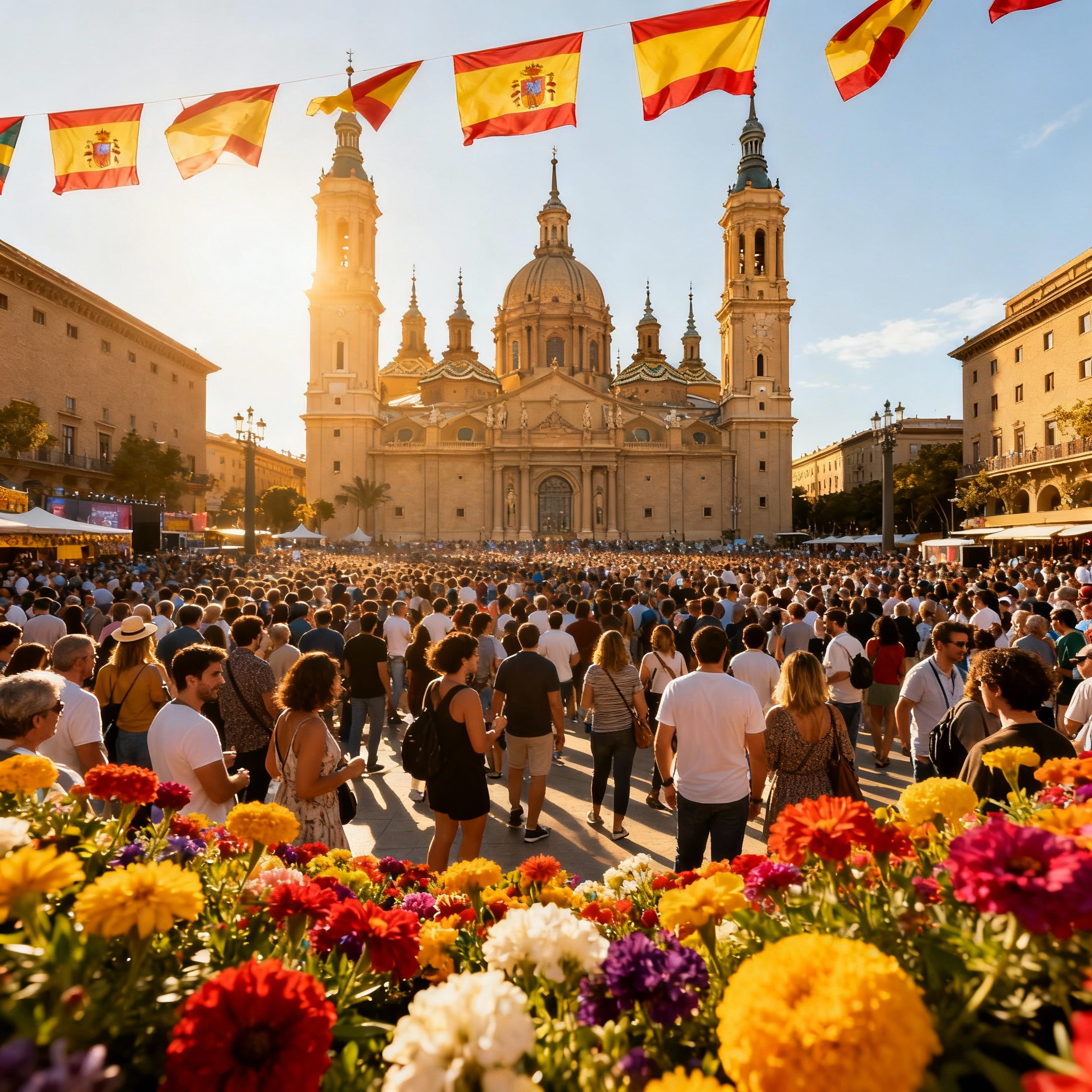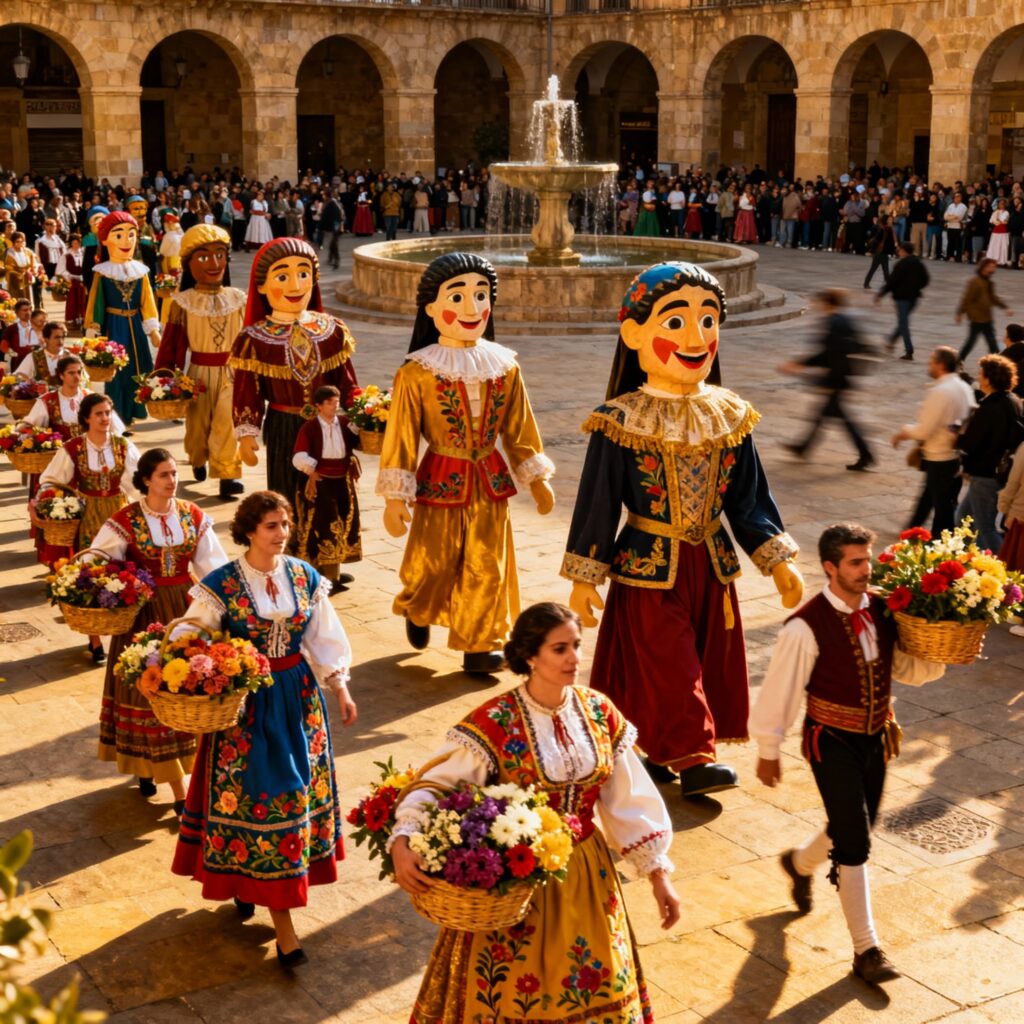
Discover the magic of the Pilar Festival, one of Spain’s most spectacular celebrations! Held annually in Zaragoza, this vibrant festival honors the Virgin of the Pillar, the city’s patron saint, with an incredible array of cultural events, traditional ceremonies, and joyous festivities that attract millions of visitors from around the world.
Introduction
The Pilar Festival (Fiestas del Pilar) is a grand celebration that transforms Zaragoza into a hub of culture, music, and tradition every October. Named after the Basilica of Our Lady of the Pillar, this week-long festival commemorates the appearance of the Virgin Mary to Saint James the Apostle on the banks of the Ebro River. Whether you’re a first-time visitor or a seasoned festival-goer, the Pilar Festival promises an unforgettable experience filled with parades, concerts, traditional dances, and mouthwatering Spanish cuisine.
History & Significance
The origins of the Pilar Festival date back to 40 AD when, according to legend, the Virgin Mary appeared to Saint James while he was preaching Christianity in Hispania. She appeared standing on a marble pillar and instructed him to build a chapel in her honor. Today, the Basilica of Our Lady of the Pillar stands as one of Spain’s most important pilgrimage sites. This magnificent baroque basilica, with its stunning domes painted by Francisco Goya, has become an architectural masterpiece that draws pilgrims and art enthusiasts from across the globe. The original chapel has been expanded over centuries into the grand structure we see today, featuring eleven domes and four towers that dominate Zaragoza’s skyline. Inside, the sacred pillar remains encased in silver and bronze, visible through an opening where pilgrims can touch and kiss it, maintaining a tradition that has continued for nearly two millennia.
The festival gained official recognition in 1678 when Pope Clement X designated October 12 as the feast day of Our Lady of the Pillar. This date also coincides with Spain’s National Day (Día de la Hispanidad), adding further significance to the celebrations. The festival represents not only religious devotion but also the cultural identity and pride of the Aragonese people. Throughout the centuries, the Fiestas del Pilar has evolved from a purely religious ceremony into one of Europe’s largest cultural festivals, attracting over 2 million visitors annually. The festival’s growth reflects the deep connection between faith and community in Spanish culture, where sacred traditions blend seamlessly with modern celebrations. As one local historian notes, ‘The Pilar Festival is the heartbeat of Zaragoza—it’s when our city truly comes alive, when past and present dance together in the streets.’ The event has become so significant that UNESCO has recognized aspects of the festival, including the jota dancing tradition, as part of Spain’s Intangible Cultural Heritage.
Main Events
The Pilar Festival features an impressive lineup of events that cater to all ages and interests. The celebrations typically run for nine days, culminating on October 12th.
Ofrenda de Flores (Flower Offering)
This is the festival’s most iconic event, where thousands of people dressed in traditional Aragonese costumes present flowers to the Virgin. The flowers are used to create a massive floral mantle covering the statue outside the basilica. This spectacular display attracts over 250,000 participants annually. The Ofrenda de Flores takes place over two days, October 11th and 12th, beginning in the early morning and continuing into the evening. Participants gather in groups representing different neighborhoods, towns, and organizations, each wearing their distinctive traditional dress. Women don elegant embroidered shawls and intricate lace mantillas, while men wear traditional baturro costumes complete with colorful sashes and distinctive caps. The procession route winds through the historic streets of Zaragoza, accompanied by the rhythmic sounds of jotas and pasodobles. Each group carries bouquets of carnations, roses, gladioli, and other vibrant flowers. As they reach the Plaza del Pilar, participants ascend a wooden ramp to place their flowers on the enormous framework surrounding the Virgin’s statue. By the end of the offering, the statue is completely covered in a towering mantle of flowers reaching heights of over 15 meters, creating a breathtaking sea of colors and fragrances. The emotional intensity is palpable—many participants have tears in their eyes as they make their offering, continuing a family tradition passed down through generations. As one participant shared, ‘My grandmother brought flowers, my mother brought flowers, and now I bring my daughter. It’s our way of saying thank you to La Pilarica for watching over our family.’

Rosario de Cristal (Crystal Rosary)
A breathtaking nighttime procession featuring 29 illuminated carriages made of crystal and depicting scenes from the mysteries of the Rosary. This unique spectacle has been a festival tradition since 1889 and draws massive crowds along the procession route. The Rosario de Cristal procession typically takes place on October 13th, starting at dusk as the city lights begin to twinkle. Each of the 29 hand-crafted carriages represents one of the mysteries of the Rosary—joyful, sorrowful, glorious, and luminous—and is illuminated from within by thousands of lights, creating an ethereal glow that reflects off the meticulously arranged crystal panels. The carriages, some weighing over 500 kilograms, are pulled through the streets by teams of dedicated volunteers who have trained for months for this honor. The procession moves slowly through Zaragoza’s historic center, allowing spectators to admire the intricate details of each carriage’s biblical scenes. The sound of sacred music and hymns accompanies the procession, performed by brass bands and choirs, creating an atmosphere that’s both solemn and magical. Families line the streets hours in advance to secure the best viewing spots, bringing blankets and snacks to make an evening of it. Children sit on their parents’ shoulders, their faces illuminated by the passing glow. The Rosario de Cristal is often described as watching a stained-glass cathedral come to life and parade through the streets. This extraordinary tradition has no equivalent anywhere else in the world, making it one of the festival’s most photographed and memorable moments.
Concerts and Performances
Throughout the festival, Zaragoza hosts hundreds of free concerts featuring everything from traditional jota music to contemporary pop and rock performances. The city’s squares and streets become open-air stages for music, dance, and theater. The festival’s concert program spans every musical genre imaginable, ensuring there’s something for everyone. Traditional jota aragonesa performances take center stage in many venues, showcasing this distinctive regional dance characterized by rapid footwork, elegant arm movements, and the accompaniment of bandurria and guitar. Professional jota groups compete in prestigious competitions, while informal peñas (social clubs) perform impromptu shows in plazas throughout the city. Contemporary music fans can enjoy performances by well-known Spanish and international artists on the main stage at Plaza del Pilar, with past headliners including both established stars and emerging talents. These concerts attract massive crowds, with tens of thousands gathering to dance and sing along under the stars. Street performers, known as rondallas, roam the historic quarter, offering spontaneous serenades. You’ll encounter everything from classical guitar duets to flamenco fusion, from jazz ensembles to children’s choirs. The Teatro Principal and Auditorio also host special festival performances, including opera, ballet, and theatrical productions with themes related to Aragonese culture and history. Don’t miss the traditional Comparsa de Gigantes y Cabezudos processions, where enormous papier-mâché figures dance through the streets to live music, delighting children and adults alike.
Traditions & Food
No Spanish festival is complete without its culinary traditions, and the Pilar Festival is no exception. The streets of Zaragoza come alive with food stalls offering traditional Aragonese delicacies. The Pilar Festival transforms Zaragoza into a gastronomic paradise, where centuries-old recipes are celebrated alongside contemporary culinary innovations. The festival’s food scene reflects Aragón’s rich agricultural heritage, drawing from the region’s diverse landscapes—from the Pyrenees mountains to the Ebro River valley. Street vendors line the historic center, particularly around the Plaza del Pilar and Calle Alfonso, offering both quick bites and elaborate traditional dishes. The aroma of roasting lamb, garlic, and wood-fired bread fills the air, mingling with the sweet scent of freshly made pastries. For foodies, the Pilar Festival offers an unparalleled opportunity to experience authentic Aragonese cuisine, much of which is rarely found outside the region. Local taverns and restaurants extend their hours during the festival, often offering special menus featuring seasonal ingredients and festival-specific dishes. The atmosphere in these establishments is electric, with groups of friends and families gathering for long meals punctuated by lively conversation, wine, and traditional songs.
Must-try dishes include:
- Ternasco de Aragón: Roasted young lamb, a regional specialty that’s protected by a Designation of Origin. This succulent meat comes from young lambs raised in the Aragonese countryside and is typically slow-roasted with aromatic herbs until the meat falls off the bone. Paired with roasted potatoes and seasonal vegetables, it’s considered the crown jewel of Aragonese cuisine.
- Migas: Fried breadcrumbs with chorizo and grapes
- Bacalao al Ajoarriero: Cod prepared with garlic and peppers in the traditional muleteers’ style. This dish features flaky salted cod cooked low and slow with olive oil, garlic, tomatoes, and red peppers until it creates a rich, comforting stew perfect for cool October evenings.
- Tortas del Pilar: Sweet pastries specially made for the festival. These delicate, flat cakes are topped with almonds and dusted with powdered sugar. Local bakeries begin preparing them weeks in advance, and they’re often given as gifts or enjoyed with morning coffee throughout the festival.
- Frutas de Aragón: Candied fruits coated in chocolate. These elegant confections feature pieces of candied orange, lemon, or cherry enrobed in rich dark chocolate. They’re a perfect souvenir to take home and share the taste of the festival with friends and family.
Traditional jota dancing and music performances fill the streets, with locals wearing colorful regional costumes. The festival also features bullfights, fireworks displays, and amusement park rides for families.
How to Experience the Pilar Festival
Planning your visit to the Pilar Festival requires some preparation, as this is one of Spain’s busiest festival periods.
Best Times to Visit: The festival runs from October 5-15, with peak events occurring on October 12th. For a less crowded experience, consider visiting during the first few days.
Accommodation: Book your hotels at least 2-3 months in advance, as Zaragoza becomes fully booked during festival week. Consider staying in nearby towns if needed.
Getting Around: Zaragoza’s city center is compact and walkable. Many events are concentrated around the Plaza del Pilar and the Basilica. Public transportation and special shuttle services operate extended hours during the festival.
What to Wear: Comfortable walking shoes are essential. If participating in the flower offering, consider traditional Aragonese attire, though it’s not required.
Pilar Festival in 2025
The 2025 Pilar Festival promises to be spectacular, with organizers planning enhanced events while maintaining cherished traditions. The festival will run from October 5-15, 2025, with the main celebrations on October 12, 2025.
Special highlights for 2025 include expanded concert programs featuring international artists, enhanced lighting displays for the Rosario de Cristal procession, and new cultural exhibitions showcasing Aragonese heritage. The city is also implementing improved crowd management systems to ensure visitor safety while maintaining the festival’s authentic atmosphere.
Conclusion
The Pilar Festival is more than just a celebration—it’s a profound expression of Spanish culture, faith, and community spirit. Whether you’re drawn by the religious significance, the stunning visual spectacles, the delicious food, or the vibrant atmosphere, this festival offers something for everyone.
From the emotional flower offering to the dazzling crystal rosary procession, from traditional jota performances to contemporary concerts, the Pilar Festival creates memories that last a lifetime. Mark your calendar for October 2025 and experience the magic of Spain’s most beloved autumn celebration!
Hashtags: #PilarFestival #FiestasDelPilar #Zaragoza #SpainFestivals #VirginOfThePillar #SpanishCulture #TravelSpain #SpainTravel #AragonSpain #SpanishTraditions #Zaragoza2025 #SpainEvents #CulturalFestival #SpainCelebration #VisitSpain



Leave a Reply